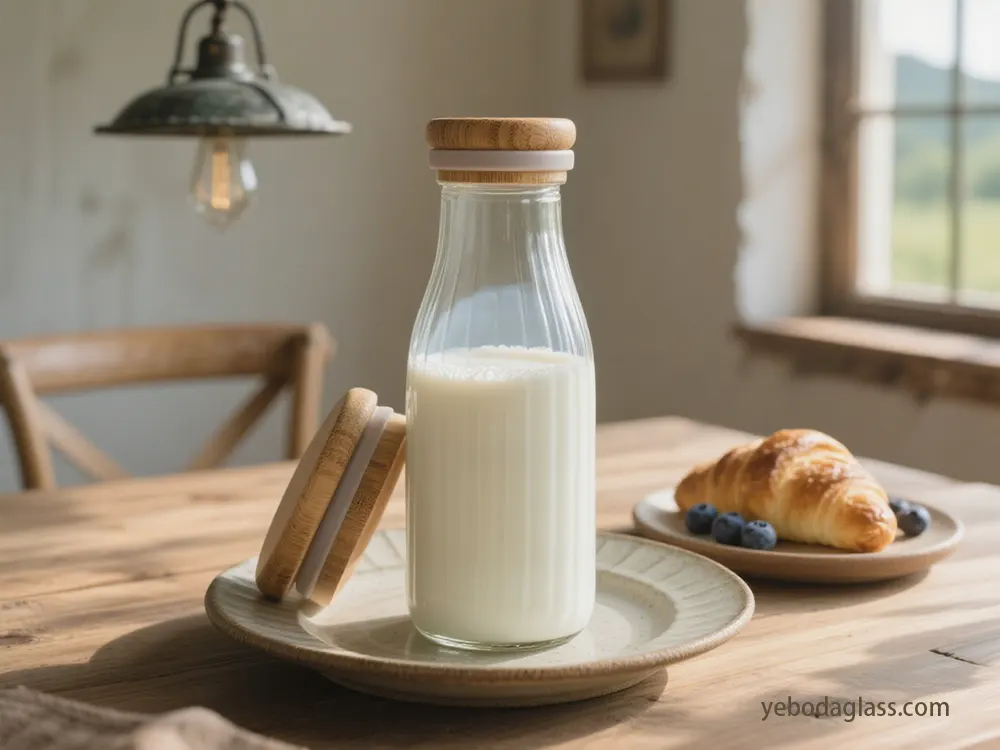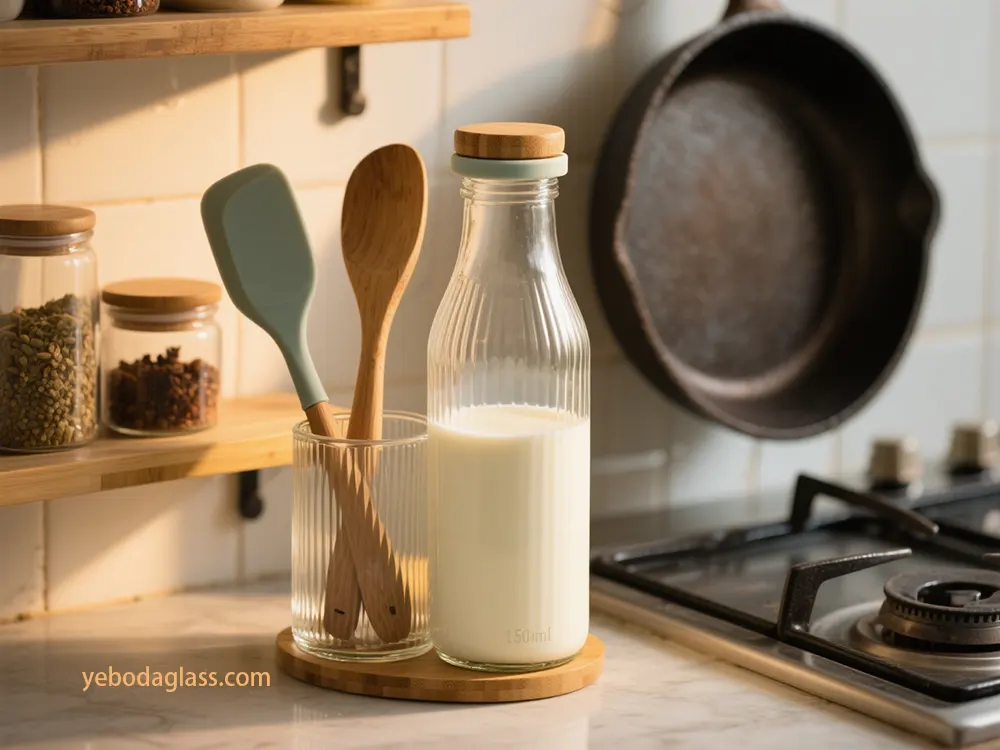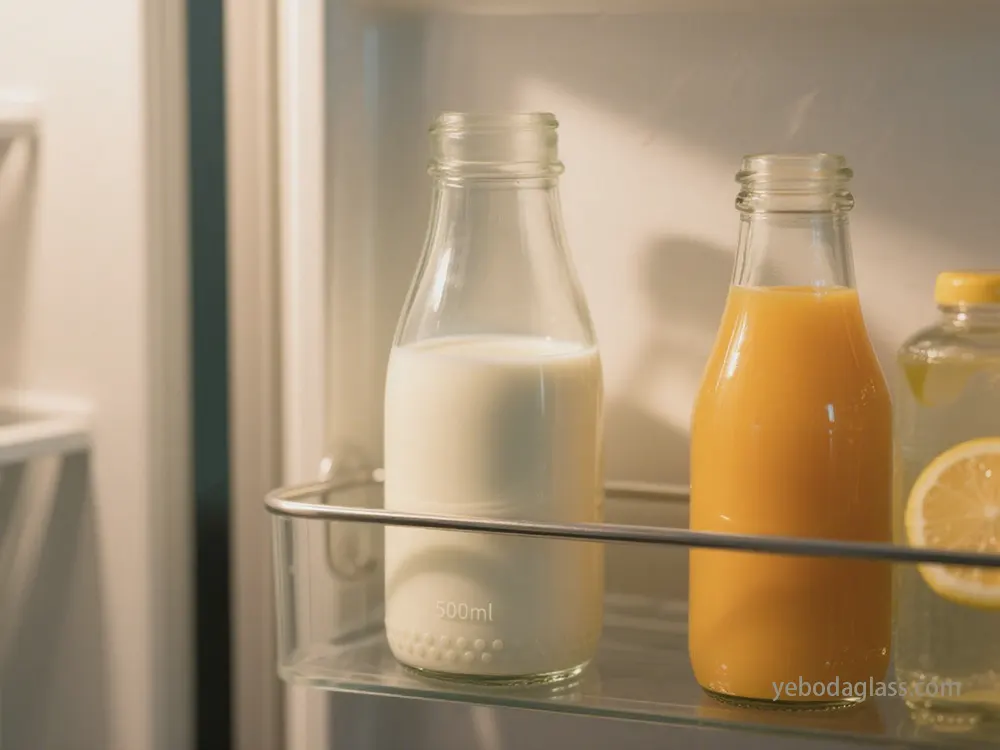PET’s lighter weight and durability allow more units per pallet, optimizing storage and transport space.This leads to better warehouse utilization compared to glass. PET bottles can also be stackable, further enhancing space optimization.
Sustainable Closures:
ความล้ำเป็นส่วนหนึ่งรวมถึงแผงหลาม (ตัวอย่างเช่น Blue Ocean Closures) และ 100% PCR รีโซล (PolyCycle PCR) หมวก PET เป็นที่รู้จักกัน rộng rãi และ “หมวกก้อน” หมายถึงการเสียสภาพ
2.3.
สำหรับนม การตกอยู่ภายใต้ข้อกำหนดคุณภาพและความปลอดภัยอย่างเข้มงวดเป็นสิ่งที่ไม่สามารถประนีประนอมได้ ทั้งนี้เพื่อคงความแนบแน่นของผลิตภัณฑ์ สุขภาพของผู้บริโภค และการตรวจสอบความตรงตามกฎหมาย
มาตรฐานระหว่างประเทศและมาตรฐานของประเทศ:
ISO 7086-1:2017:
กำหนดวิธีการทดสอบสำหรับการปล่อยสารหลังแร่และแร่หนึ่งจากแก้วสำหรับการสัมผัสอาหาร
- CCC Certification:
- หลักฐานทางสังคม: FDA Compliance (USA):
- FDA ควบคุมกระดาษบรรจุภัณฑ์แก้วในฐานะส่วนประกอบของอาหารที่ไม่ตรงตามโดยตรง; แก้วน้ำเหลืองเป็นที่วินิจฉัยว่าปลอดภัย (GRAS) EU Food Contact Regulations:
- การตรงตามกฎหมาย (EC) No 1935/2004 เป็นสิ่งจำเป็นสำหรับการ xuất khẩuของ EU การตรงตามของบริษัทเฉพาะ:
- 4.1. Closed-Loop Recycling and Certifications ระบบการประกันคุณภาพและการตรวจสอบฝ่ายที่สาม:
- ISO 9001 และ GMP: โครงสร้างการประกันคุณภาพที่แข็งแรงสนับสนุนการดำเนินงานที่มีคุณภาพและตรงตามกฎหมายอย่างสม่ำเสมอ
- การรับรองจากฝ่ายที่สาม: หน่วยงานอิสระ (ตัวอย่างเช่น NSF International, Intertek, SGS) ทำการตรวจสอบความตรงตามผ่านการประเมินและการลองทดสอบ
- ความปลอดภัยของวัสดุ:
- ทุกวัสดุพลาสติก โลหะ และเอลาสโทเมอร์ในการปิดหรือส่วนเพิ่มเติมต้องมีความยืดเยื้อ ทนต่อการเปลี่ยนแปลงทางเคมี และเป็นระดับอาหารเพื่อหลีกเลี่ยงการระเบิด 2.4. ความต้องการของการแต่งแบบและตกแต่งแบบเฉพาะ
- การตกแต่งแบบเฉพาะทำให้ภาชนะที่มีวัตถุประสงค์มากมายกลายเป็นเครื่องมือการแต่งแบบที่มีเฉพาะ ซึ่งมีผลต่อความทนทาน ราคา และขนาดการส่งผลต่อสิ่งแวดล้อม ทำเครื่องแต่งตัว:
- การพิมพ์กล่อง วิธีการที่เป็นไปได้หลากหลาย มีราคาที่มีความสมานสัมพันธ์ โดยใช้สีอินทรีย์หรือสีที่แช่แดงด้วย UV เพื่อทำการพิมพ์ที่มีความยืดเยื้อ 360 องศา
- สีอินทรีย์: ทางเลือกที่มีความเป็นมนุษย์ สำหรับการผลิตจำนวนมาก สร้างภาพเขียวสด; ภาชนะสามารถถูกเอามาใช้ใหม่ได้โดยสมบูรณ์ครับ การพิมพ์แก้วด้วย UV ดิจิตอล: วิธีการที่มีความก้าวหน้าใช้แสง UV เพื่อแช่แดงสี สนับสนุนการเปลี่ยนแปลงสีที่เป็นไปได้และการออกแบบที่มีความละเอียดสูง
- การพิมพ์เซอรามิก: ความทนทานและการทนทานต่อการสไลส์ที่ดี; สีถูกผสานคงที่กับแก้วในระหว่างการทำให้แช่แดงที่มีความร้อนสูง
การพิมพ์ด้วยความร้อน:
การน้ำเหลืองที่ผสมเป็นภาชนะที่มีความทนทานต่อการสไลส์สูง
- การจัดลวดทองหรือสี:
- การใช้ฟอยล์ทองหรือสีเพื่อสร้างความรู้สึกหรูหรา การฉีดเหล็ก:
- การเพิ่มความงามและความทนทานต่อการรากหย่อน การฉีดสี:
- การเปลี่ยนแปลงความแข็งแรงและความน่าตื่นตาด้วยสีที่เลือกเอง การป้องกันสี และโครงสร้างที่เป็นเอกลักษณ์ การขึ้นตัวด้วยเลเซอร์:
- เทคนิคที่แม่นยำ ที่เปลี่ยนพื้นผิวของกระจกด้วยเลเซอร์ ที่นิยมใช้สำหรับสินค้าหรูหรา ความทนทานและการเข้าสัมผัส:
- การเข้าสัมผัสของสี UV: การเข้าสัมผัสที่ดีที่สุดมักจะต้องการการเตรียมพร้อมที่เฉพาะ เช่น การพิมพ์บน “เขตอากาศ” ของกระจกแบน
- การเตรียมพร้อม:
- การล้างพื้นผิวกระจกด้วยแอลกอฮอล์เป็นสิ่งจำเป็น ยานต์เข้าสัมผัส:
- ยานต์เช่น Natron G1 UV มักจะต้องการ โดยเฉพาะสำหรับภาชนะที่ฝังแร่เย็นที่มีแม้งความชื้น การประคบไฟ:
- ระบบการประคบไฟก่อนซึ่งมีความก้าวหน้า (เช่น Pyrosil kits) มีความสำคัญในการเพิ่มการเข้าสัมผัสของสี ทำให้ภาชนะที่ตกแต่งแล้วสามารถทนทานต่อการล้างหลายครั้ง โครงสร้างของสี:

โครงสร้างของสีมีบทบาทสำคัญ สี UV บางชนิดที่เฉพาะเจาะจงต้องการการร้อนหลังการพิมพ์และการแช่แข็งด้วย UV อิสิมาต’s UVitro Technology ใช้สี UV อินทรีและมีการเข้าสัมผัสที่ดี โดยมักจะมีการประคบไฟก่อนด้วยแพลสมา
ความเป็นไปได้และการป้องกันสิ่งแวดล้อม:
- ปัจจัยค่า:
- ค่าที่มีผลต่อวัสดุ (กระจกฝ้าย กระจกส้ม กระจกเขียว), ปริมาณสั่งซื้อ และความซับซ้อนของการเปลี่ยนแปลง พร้อมเม็ดลวดเป็นการลงทุนต้นสัมพันธ์ที่สำคัญ ($1,500-$11,000) การทดสอบเป็นต้นทุน $500-$2,000 การผลิตที่มี quy môใหญ่สามารถทำได้ $1-$3 ต่อภาชนะ; ความเล็กน้อย $5-$10 ให้เวลา 6-12 สัปดาห์สำหรับการสั่งซื้อที่เปลี่ยนแปลง; การสร้างเม็ดลวดที่เปลี่ยนแปลงอาจใช้เวลาหลายเดือน
- กระจกสามารถถูกบำบัดซ้ำได้เรื่อยๆ การพิมพ์กระจกแบบเฉพาะลดการกำจัดซากปุ๋ยโดยลบการติดป้ายแบบเดิม ทางเลือกของสีที่ป้องกันสิ่งแวดล้อมลดการปล่อย VOC บางบริษัทใช้กระบวนการที่ไม่มีสำหรับโลหะหนักและพลังงานสีเขียว การประเมินความสามารถของผู้จัดหาซื้อและการป้องกันคุณภาพ
- การประเมินผู้จัดหาซื้อกระจกแบบนมอย่างลึกซึ้งเพื่อให้แน่ใจคุณภาพที่สม่ำเสมอ ความปลอดภัย และความสะดวกในการผลิต การผลิตและความเชี่ยวชาญในการผลิต
- การผลิตของผู้จัดหาซื้อเชื่อมโยงกับผลผลิตปัจจุบันและความสามารถในการขยายและปรับตัวต่อความต้องการที่มีความเปลี่ยนแปลง Capacity Audit:
- A comprehensive audit assesses manufacturing capability, flexibility for surge orders, preventative maintenance schedules, and use of ERP/MRP systems. Manufacturing Stages and Control:
- Understanding the entire process—raw material preparation, melting, forming, annealing, surface treatment, inspection, packaging—is key. Precise temperature control prevents defects.Proper annealing relieves internal stresses. Technological Advancement:
- Suppliers the use of excessive-precision molds, automatic strains, and superior surface treatment technologies supply regular nice, higher performance, and reduced defects. 3.2. Adherence to Food-Grade Standards
- Given strict dairy guidelines, a supplier’s unwavering dedication to food-grade requirements is paramount. GFSI Standards:
- Compliance with Global Food Safety Initiative (GFSI) standards indicates dedication to food safety, mandating documented approval processes for packaging suppliers.
- Approved Supplier List: The supplier must maintain a meticulously managed approved supplier list for all materials, including food contact packaging.
- Regulatory Compliance: Ensure compliance with specific regional and national regulations (FDA, EU Food Contact Regulations, FSSAI). Reputable manufacturers explicitly state compliance with USP Type-III glass standards.
- Quality Assurance Systems: Robust ISO 9001 and GMP systems ensure consistent quality, traceability, and continuous regulatory compliance.
- All materials in bottles and components must be durable, chemically inert, and food-grade to prevent harmful substance migration. 3.3. Robust Quality Control Processes
- A supplier’s quality control (QC) processes are essential for preventing defects, ensuring product integrity, and consumer safety. Quality Control Importance:
- Rigorous QC prevents defects, optimizes production efficiency, minimizes waste, reduces costs, and maintains market competitiveness.
- Defect Identification and Categorization: Suppliers need clear protocols for identifying, categorizing, and addressing defects. Common surface defects include bubbles, scratches, cracks, and chips.Defects are categorized by severity: Minor, Major, or Critical.
- Diversification: Finished bottles undergo visual inspection (manual or automated) for defects.Automated systems use algorithms and high-speed cameras.
- ความยั่งยืน Bottles are rigorously tested for impact, internal pressure, and temperature variations.Regular testing intervals are essential; if one bottle fails, four more from the batch are tested, and if any retested bottles fail, the entire batch is quarantined.
Raw Material Quality:
Silica sand quality is paramount, requiring freedom from impurities.
Functional Standards:
Containers must pass stringent functional inspections for seamless operation on filling lines and safe product containment.
- Appearance and Chemical Checks: Routine appearance inspections and chemical checks for heavy metals ensure food safety compliance.
- Team Effort: Consistent high-quality bottle production requires a collaborative team effort.
- 4. Logistics, Lead Times, and Supply Chain Resilience Optimizing glass bottle procurement logistics is paramount for dairy brands, given unique challenges.
4.1. Supplier Proximity and Transportation Efficiency
Supplier geographic location significantly impacts logistics costs and lead times.
- Proximity Benefits: Sourcing from nearby suppliers reduces transportation fees, a substantial cost component based on distance, quantity, weight, and fuel prices.
- Weight and Fragility of Glass: Glass bottles are considerably heavier than plastic, leading to higher transportation costs from raw materials to final delivery.Increased weight also means higher warehousing expenses.
- Dimensional Weight: Shipping costs are influenced by both physical and dimensional weight. Minimizing package size and using appropriate packaging reduces costs.
- Freight Optimization: Consolidating shipments leverages volume discounts.Advanced shipping software automates processes and optimizes package sizes.
- ระบบการประคบไฟก่อนซึ่งมีความก้าวหน้า (เช่น Pyrosil kits) มีความสำคัญในการเพิ่มการเข้าสัมผัสของสี ทำให้ภาชนะที่ตกแต่งแล้วสามารถทนทานต่อการล้างหลายครั้ง While glass bottles don’t require cold chain, dairy products do. Dairy logistics necessitate quick transportation and strict temperature control via refrigerated vehicles and monitoring.Packaging must protect products from temperature/humidity variations.
4.2. Preferred Lead Times
Lead times are critical for inventory management and production planning, impacting market responsiveness.
- Custom Orders: Custom glass bottle orders require longer lead times: 6 weeks for smaller orders, up to 12 weeks or more for large volumes/intricate designs.
- Custom Molds: Mold creation for unique designs is time-intensive, often taking several months.
- Lead Time as a KPI: Lead time is a key performance indicator (KPI) for supplier performance, measuring delivery time after order. Shorter, predictable lead times enhance efficiency, reduce holding costs, and improve market responsiveness.
- 4.3. Supply Chain Resilience Building a resilient deliver chain mitigates disruptions and ensures consistent product availability for perishable dairy.
- Diversification of Suppliers: การหลายหลายการจัดหาแหล่งซื้อในภูมิภาคลดการขึ้นตามแหล่งซื้อเดียว และลดผลกระทบจากการขัดข้องท้องถิ่น
- การ quản lý rủi ro và đánh giá: ดำเนินการตรวจสอบความเสี่ยงเรื่อยๆ เพื่อค้นหาความเสี่ยงในหลักสู้ส่ง อ่านความน่าเชื่อถือของผู้จัดหา ความเสี่ยงทางการเมืองเศรษฐกิจ และการขัดข้องจากภาวะอากาศ เงื่อนไขการจัดการความเสี่ยงของผู้จัดหาที่เป็นทางการควรรวมถึงความมั่นคงทางการเงิน การควบคุมคุณภาพ การทำตามกฎหมาย การอยู่รอบต้นไม้สิ่งแวดล้อม และปัจจัยทางการเมืองเศรษฐกิจ
- การวางแผนฉุกเฉิน: พัฒนาแผนฉุกเฉินที่ชัดเจน โดยระบุข้อบังคับ หน้าที่ กำหนดเวลา และเกณฑ์การประสบความสำเร็จสำหรับกรณีการขัดข้อง ผู้ให้โอกาสที่มีการรับรองก่อนเป็นสำคัญ
- ความยืดหยุ่นและการปรับปรุงสต็อก: รักษาความยืดหยุ่นเพื่อปรับตัวต่อความต้องการที่เปลี่ยนแปลง สต็อกเป็นที่รักษาที่เป็นกลยุทธ์สำหรับวัสดุสำคัญเช่น ของเหล็กใบปัดป้องกันการขัดข้อง
การรวมองค์ประกอบความยั่งยืน:
การประเมินปัจจัย ESG ในการประเมินความเสี่ยงของผู้จัดหาเป็นสำคัญ การผลิตของเหล็กที่ยั่งยืนใช้พลังงานที่สามารถใช้ได้เรื่อยๆ เพื่อลดราคาและลดการปล่อยคาร์บอน การบำบัดของเหล็กลดความต้องการวัสดุแรกเจ้า การใช้พลังงาน และมลพิษ; แต่ละตันของของเหล็กที่บำบัดได้ช่วยลด CO2 246 กก. กฎหมาย ESG ที่กำลังพัฒนาทำให้ความยั่งยืนของผู้จัดหาเป็นการทำตามกฎหมายที่สำคัญ
ความก้าวหน้าทางเทคโนโลยีสำหรับความเห็นได้และการพยากรณ์:
Blockchain:
- ปรับปรุงความชัดเจน ความสามารถในการติดตาม และความเป็นไปได้ในหลักสู้ส่งบริการ ป้องกันการขาดจำหน่ายด้วย QR/NFC/RFID tags AI-Driven Predictive Analytics:
- คาดการณ์การขัดข้อง ปรับปรุงสต็อก และปรับปรุงการพยากรณ์ความต้องการ AI จัดการข้อมูลในระดับสูงสำหรับความเข้าใจ และออกแบบการซื้อและการพยากรณ์ การสκολบตรวจสอบส่วนตัว:
- เซนเซอร์ IoT และ RPA ให้การสามารถเห็นรอบทุกมุมของการดำเนินงานและลำดับส่งสินค้า สามารถตอบสนองทันที การเชื่อมโยงส่งสินค้าของนม:
- ความชัดเจนของข้อมูล: การขาดความชัดเจนของข้อมูลเป็นการขัดขวางการร่วมมือ นำไปสู่ความเป็นไปได้ที่ไม่ดี การมองเห็นสามารถใน thời gian real-time เป็นสำคัญ
- การจัดการสต็อกที่แม่นยำ: สำคัญเพื่อป้องกันการหลีกเลี่ยงการล้มเหลวของสินค้าและให้การมีอยู่ไว้ที่สม่ำเสมอ
การรวมการทำตามกฎหมาย:
การรวมการตรวจสอบการทำตามกฎหมายในแผนหลักสูงลดความเสี่ยง
- ระบบที่เก่า: : ระบบที่เก่าอาจขาดความถูกต้องของข้อมูลและการมองเห็นใน thời gian real-time
- การลดผลกระทบของ Bullwhip Effect: แอลกอริทึม Genetic Algorithms (GAs) สามารถลดผลกระทบของ “Bullwhip Effect”
- การวางแผนฉุกเฉินท้องถิ่น: การเก็บสต็อกเป็นที่รักษาท้องถิ่นให้เพียงพอเพื่อส่งสินค้าได้อย่างรวดเร็วในขณะที่มีการขาดแคลน

การวิเคราะห์ต้นทุนและค่าที่มีความหมาย
A comprehensive cost analysis for YEBODA’s milk glass bottles extends beyond unit price, encompassing Total Cost of Ownership (TCO) for full financial implications and long-term value.
- 5.1. Budget Range Per Bottle Glass bottle prices vary significantly based on size, thickness, customization, and contract nature.
- Average Price Range: Prices normally range from zero.18toover0.18tooverX.XX according to unit.Less than 12 ouncesability: two hundred−200−800 in step with 2,500 bottles; over 12 oz.: 1,000−1,000−6,500 according to 2,500 bottles.Standard, high-volume bottles: 0.1–zero.5USD;premium/custom designed:zero.1–0.5USD;top class/customized:1–3 USD or extra.
- Raw Material Costs: Primary materials include quartz sand, soda ash, and limestone.Cullet (recycled glass) proportion impacts cost and sustainability.
- Production Costs: Encompass substantial utility costs (energy-intensive), labor, and machinery maintenance.
- Customization: Customized designs increase costs due to unique molds and specialized decoration.
- Market Trends:
- YEBODA must stay informed on market trends and raw material price fluctuations. Glass prices in the US are projected to increase 3.6% from 2022-2025. 5.2. Total Cost of Ownership (TCO)
- TCO provides a holistic view of all costs throughout the bottle’s lifecycle, revealing hidden expenses and savings. Beyond Purchase Price:
- Unit price is a starting point; numerous hidden and indirect costs impact economic viability. Freight and Logistics Costs:
- Glass bottles are substantially heavier than plastic, leading to significantly higher transportation and warehousing costs.Strategic design (lightweighting), bulk purchasing, and nearby sourcing can mitigate these costs.
- Breakage Rates: Glass is more prone to breakage than plastic during transit, handling, and on filling lines, resulting in product loss, waste, line downtime, and safety concerns.
- Quality Control Costs: Stringent QC for glass bottles, including labor and specialized equipment, adds to operational cost.
- Line Efficiency: Breakage and handling issues with glass can reduce filling line efficiency, impacting throughput and increasing operational costs.
- End-of-Life Costs and Reusability:Recycling Infrastructure:
- While infinitely recyclable, cost-benefit and environmental impact depend on local recycling program efficiency. Reusable Systems:
- Reusable glass bottles are cost-effective and environmentally preferable if they achieve sufficient reuse cycles (typically 25-30). การล้างและความสะอาด:
สำหรับระบบที่สามารถนำมาใช้ใหม่ ค่าใช้จ่ายที่สำคัญสำหรับการรวบรวม ล็อกเซอร์ด้านตรงกันข้าม การล้างและความสะอาดต้องนับเป็นส่วนหนึ่งของ TCO
พฤติกรรมของผู้บริโภค:
ความสำเร็จของการใช้วัตถุดิบที่สามารถนำมาใช้ใหม่ขึ้นอยู่กับความต้องการของลูกค้าที่จะนำภาชนะมาใช้ใหม่;ความไม่สะดวกอาจเป็นข้อขัดขวางที่มหาศาล
5.3. การประเมินค่าของการเสนอและความยั่งยืน
- นอกเหนือจากค่าใช้จ่ายทางเศรษฐกิจ ค่าที่เหมาะสมรวมถึงคุณภาพของผลิตภัณฑ์ ความน่าเชื่อถือของผู้ขนส่งและการตรงกับความต้องการความยั่งยืนของเสมาะ การประเมินช่วงชีวิต (LCA):
- สำคัญต้องเปรียบเทียบผลกระทบทางสิ่งแวดล้อมของกระดาษและพลาสติก โดยคิดถึงการดึงส่วนผสมที่ไม่เป็นผลิตภัณฑ์ การผลิต การขนส่ง การใช้งาน และสิ้นสุดช่วงชีวิตบาง LCA แนะว่าพลาสติกจะมีผลกระทบทางสิ่งแวดล้อมต่ำกว่ากระดาษเนื่องจากน้ำหนักและการผลิตที่ต้องใช้พลังงานมากของกระดาษ การปล่อยคาร์บอนไดออกไซด์และการใช้น้ำ:
- การผลิตและขนส่งกระดาษทำให้เกิดการปล่อยคาร์บอนไดออกไซด์;การเพิ่มการใช้กระดาษที่ถูกซ่อมแซมลดการใช้พลังงานและการปล่อยคาร์บอนไดออกไซด์การล้าง/ความสะอาดสำหรับภาชนะที่สามารถนำมาใช้ใหม่ต้องใช้น้ำมาก ประโยชน์ทางสิ่งแวดล้อมของการใช้งานซ้ำ:
- ภาชนะกระดาษที่สามารถใช้งานซ้ำจะเป็นทางเลือกที่ดีกว่าต่อสิ่งแวดล้อมหลังจากวงจรการใช้งานซ้ำบางรอบ (ตัวอย่างเช่น 3 สำหรับ 0.5L จนถึง 25 สำหรับ 2L) ความแตกต่างท้องถิ่น:
- การบรรจุแบบที่ดีที่สุดมีความแตกต่างตามปัจจัยท้องถิ่น:โครงสร้างการบำบัดซ้ำ ค่าใช้จ่ายการขนส่ง และความต้องการของผู้บริโภค ความยั่งยืนของผู้จัดหา:
ประเมินผู้จัดหาตามการปฏิบัติที่มีการยืนยันความยั่งยืน:พลังงานที่สามารถใช้ได้ การจัดการน้ำ และวัสดุที่มีความเป็นมิตรกับสิ่งแวดล้อมตั้งเกณฑ์ที่ชัดเจนสำหรับความยั่งยืนของผู้จัดหาที่ตรงกับเป้าหมาย ESG ของบริษัทและข้อกำหนดของกฎหมาย
6. การเลือกผู้จัดหายอดและการพัฒนาความสัมพันธ์ร่วมทำงาน
- ระดับสุดท้ายคือการทำความสะอาดอย่างเข้มงวด การคัดเลือกผู้จัดหาที่เหมาะสม และการตัดสินใจเลือกผู้จัดหากระดาษแก้วนมที่เหมาะสม ซึ่งตามมาด้วยการส่งเสริมความสัมพันธ์ร่วมทำงานระยะยาว ที่มีผลเป็นผลร่วมกัน YEBODA สามารถแยกตัวซักกันในหลักสูงโดยการเปลี่ยนไปสู่สหภาพทางยุทธศาสตร์ 6.1. การเลือกผู้จัดหาที่มีโครงสร้างและการตรวจสอบ
- วิธีการที่เข้มงวดที่ชี้ระบุผู้จัดหาที่มีค่าทั้งหมด ผสมระหว่างความเป็นราคาสมเหตุผล คุณภาพ และการบริการที่น่าเชื่อถือ กระบวนการประเมินผู้จัดหา:
- กระบวนการหลายขั้นตอนรวมถึงการระบุ การประเมิน การรับรอง การตรวจสอบอย่างต่อเนื่อง และการแถลงหนี้ ซึ่งตรงกับความต้องการของกฎหมายที่เข้มงวด การประเมินและการจัดการความเสี่ยง:
- ปฏิบัตินโยบายการจัดการความเสี่ยงของผู้จัดหาที่ครอบคลุมความมั่นคงทางการเงิน การควบคุมคุณภาพ การตกลงตามกฎหมาย ความยั่งยืนทางสิ่งแวดล้อม และปัจจัยทางการเมืองตะวันออกกลาง ใช้โมเดลที่มีข้อเกณฑ์และแข็งแกร่งตรงกับการประเมินกับโครงสร้างอุตสาหกรรมเช่น NIST CSF v2.0 ISO 27001 และ ISO 13485 ทำการตรวจสอบในระดับที่เข้มงวด รวมถึงการมาเยี่ยมตรวจสอบที่สถานที่ รักษารายชื่อผู้จัดหาที่ได้รับการรับรองอย่างเคร่งครัด และอัปเดตบ่อยครั้ง สามารถเข้าถึงได้โดยผู้เชี่ยวชาญที่เกี่ยวข้อง
- การทดสอบและกำหนดเกณฑ์: จัดการการทดสอบอย่างเข้มงวดกับผู้จัดหาที่มีโครงสร้างเฉพาะ (เมาตรวัด การตกลงตามกำหนดเกณฑ์ การตรวจสอบคุณภาพ) เพื่อตัดสินใจอย่างตรงไปตรงมาว่าพวกเขาสามารถตอบสนองความต้องการได้
- การตรวจสอบคุณภาพ:
- ปฏิบัติการตรวจสอบครอบคลุมที่รวมถึงคุณภาพของกระดาษ/พลาสติก ความสมบูรณ์ของการปิด คุณภาพของปลายภาชนะ คุณภาพของป้าย/การพิมพ์ การเทียบสี และรูปทรง ขนาด น้ำหนัก ความจำเป็น ความชัดใส และความหนาของภาชนะ/หีบ ให้ความตามต้นตอนที่แน่นอนตาม REACH กฎหมายสำหรับการติดต่ออาหารของสหภาพยุโรป และคำสั่งให้ใช้ 94/62/EC อาจเรียกร้องให้รับตัวอย่างก่อนการผลิตครั้งแรก และเรียกร้องความชัดเจนในรายการของโรงงานการผลิตและได้รับอนุญาตให้ตรวจสอบโดยตรงและตรวจสอบ โครงการ SOP ของผู้จัดหา:
- New vendors must undergo formal qualification and approval by QA before supplying packaging material.KPIs and risk-based monitoring strategies ensure ongoing compliance. 6.2. Contract Negotiation
- Effective contract negotiation secures favorable terms for pricing, delivery, quality, and intellectual property protection. Key Contract Clauses:
- Quality Standards: Explicitly define precise quality expectations and conditions for glass bottles; consistent failure should constitute a material breach.
Volume Requirements:
Clearly specify quantities, MOQs/maximums, and volume adjustment provisions.
- Pricing Models and Adjustments: Common models include volume-based and unit-based pricing.Ensure transparent understanding of cost components for cost-plus pricing.Define price adjustment mechanisms.
- Intellectual Property (IP) Rights: Define IP ownership in custom molds.Design patents protect aesthetic features.Trade dress protects overall visual appearance.Copyrights protect logos and artwork.NDAs with manufacturers are essential.Conduct due diligence to avoid infringing existing patents
- Force Majeure: Include a robust clause outlining sports excusing non-overall performance (herbal disasters, pandemics, political instability)Requires well timed notification and company continuity plans.
- Dispute Resolution: Detail easy processes: direct negotiation, mediation, arbitration, or litigation.
- Termination Clause: Address clear termination rights and conditions [122].
Service Level Agreements (SLAs):

Establish comprehensive SLAs based on agreed pricing to continuously improve performance.
Confidentiality and Amendments:
Include robust terms for confidentiality and procedures for amending the agreement.
- Inspection and Compensation: Contract should contain explicit clauses on inspection conditions and compensation for non-conforming goods.
- Contract Manufacturing (if applicable): Negotiate terms like visibility on component suppliers/prices, transparent pricing, low MOQs, direct contracts with component suppliers, new product development resources, and production flexibility.
- Weight and Fragility of Glass: Negotiate fine quantity reductions and long-time period contracts for strong pricing.Maintain specific, unambiguous written verbal exchange, specifically with worldwide providers.Foster collaboration by means of concerning suppliers in key decisions.Be open and bendy to construct rapport and agree with.Conduct normal settlement critiques to become aware of and mitigate disputes.
- Supplier Incentives: Utilize financial (bonuses, discounts), reputation-primarily based (awards), performance-primarily based (delivery, exceptional), in-type (education), and shared-risk/reward incentives.Customize incentive programs to provider desires, competencies, and historic overall performance, putting practical goals.
- Quality Control Verification: Implement comprehensive inspections covering glass/plastic quality, sealing integrity, cap quality, label/print quality, color comparison, and bottle/jar shape, size, weight, capacity, transparency, and thickness.Ensure unwavering compliance with REACH, EU Food Contact Regulation, and Directive 94/62/EC.Insist on approving pre-production samples.Demand full transparency regarding manufacturing site and obtain permission for direct oversight and auditing.
- Vendor Qualification SOP: New vendors must undergo formal qualification and approval by QA before supplying packaging material.KPIs and risk-based monitoring strategies ensure ongoing compliance.
6.2. Contract Negotiation
Effective contract negotiation secures favorable terms for pricing, delivery, quality, and intellectual property protection.
- Key Contract Clauses:
- Quality Standards: Explicitly define precise quality expectations and conditions for glass bottles; consistent failure should constitute a material breach.
- Volume Requirements: Clearly specify quantities, MOQs/maximums, and volume adjustment provisions.
- Pricing Models and Adjustments: Common models include volume-based and unit-based pricing.Ensure transparent understanding of cost components for cost-plus pricing.Define price adjustment mechanisms.
- Intellectual Property (IP) Rights: Define IP ownership in custom molds.Design patents protect aesthetic features.Trade dress protects overall visual appearance.Copyrights protect logos and artwork.NDAs with manufacturers are essential.Conduct due diligence to avoid infringing existing patents
- Force Majeure: Include a robust clause outlining sports excusing non-overall performance (herbal disasters, pandemics, political instability)Requires well timed notification and company continuity plans.
- Dispute Resolution: Detail easy processes: direct negotiation, mediation, arbitration, or litigation.
- Termination Clause: Address clear termination rights and conditions [122].
- Service Level Agreements (SLAs): Establish comprehensive SLAs based on agreed pricing to continuously improve performance.
- Confidentiality and Amendments: Include robust terms for confidentiality and procedures for amending the agreement.
- Inspection and Compensation: Contract should contain explicit clauses on inspection conditions and compensation for non-conforming goods.
- Contract Manufacturing (if applicable): Negotiate terms like visibility on component suppliers/prices, transparent pricing, low MOQs, direct contracts with component suppliers, new product development resources, and production flexibility.
- Negotiation Strategies: Negotiate fine quantity reductions and long-time period contracts for strong pricing.Maintain specific, unambiguous written verbal exchange, specifically with worldwide providers.Foster collaboration by means of concerning suppliers in key decisions.Be open and bendy to construct rapport and agree with.Conduct normal settlement critiques to become aware of and mitigate disputes.
- Supplier Incentives: Utilize financial (bonuses, discounts), reputation-primarily based (awards), performance-primarily based (delivery, exceptional), in-type (education), and shared-risk/reward incentives.Customize incentive programs to provider desires, competencies, and historic overall performance, putting practical goals.
โดยการทำตามกำหนดเหมาะแก่นี้อย่างเคร่งครัด บริษัท YEBODA สามารถจัดตั้งเครือข่ายจัดส่งที่แข็งแกร่ง ทนทาน และเป็นไปได้ยั่งยืนสำหรับภาชนะกระดาษขวดนมของพวกเขา และให้การรับรองคุณภาพผลิตภัณฑ์ที่สม่ำเสมอ ปรับปรุงความเป็นไปได้ของการดำเนินงาน และปลอดภัยความสำเร็จของแบรนด์ในอนาคตยาวนานในตลาดที่เคลื่อนไหว

